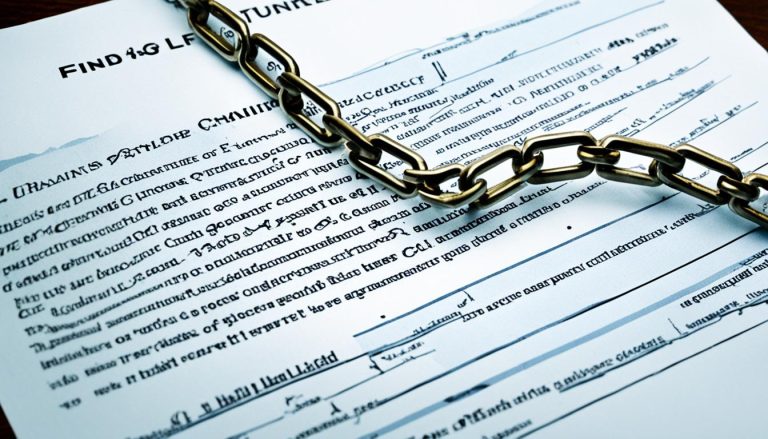Have you ever found yourself in a situation where you needed to give up something valuable in order to move forward? If so, you’re not alone. In this blog post, we’ll explore the concept of the “Deed of Surrender” and how it can lead us toward greater growth, acceptance, and, ultimately, peace. So grab a cup of tea, and let’s dive into this transformative journey together.
What is the Deed of Surrender?
A Deed of Surrender is a legal document that officially ends a tenancy agreement between a landlord and tenant. It can be agreed upon verbally or written and signed by both parties. Once the Deed of Surrender is signed, the tenant no longer has any legal rights to occupy the property. It is important to note that signing a Deed of Surrender does not release the tenant from any financial obligations they may have under the tenancy agreement.
Whether you are a landlord or a tenant, it is essential to understand the process and implications of a Deed of Surrender. This article will guide you through the drafting process, discuss when and why a tenant or landlord should use a Deed of Surrender, and highlight the consequences of signing such a document.
To begin with, let’s explore the detailed aspects of a Deed of Surrender and how it can help facilitate the smooth end of a tenancy agreement.
How to Draft a Deed of Surrender?
When drafting a Deed of Surrender, it is important to include all the necessary details to ensure a legally valid and binding agreement. Here’s a step-by-step guide on how to create a Deed of Surrender:
Gather the Essential Information
To start, gather the following information:
- The date of the surrender
- Names of the landlord and tenant
- Address of the property
- End date of the tenancy agreement
- Confirmation of key return
Formatting the Deed
Once you have all the necessary information, format the Deed of Surrender in a clear and concise manner. You can use a surrender template or seek legal advice to ensure the document complies with all relevant laws and regulations.
Inclusion of Key Clauses and Terms
Include the following key clauses and terms in the Deed of Surrender:
- The agreement that the tenant will surrender the property and terminate the tenancy on the specified date
- The agreement that the landlord will accept the surrender and release the tenant from all further obligations under the tenancy agreement
- A statement confirming that the tenant has returned all keys, possessions, and access devices to the property
- A clause stating that the tenant no longer has any right to occupy the property
- A clause stating that both parties have read and understood the terms of the Deed
Signing and Witnessing the Deed
Once the Deed is drafted, it should be signed by both the landlord and the tenant. It is also important to have the signatures witnessed by a third party who is not party to the agreement.
By following these steps and using a surrender form or template, you can create a legally binding Deed of Surrender that protects the rights and interests of both the landlord and the tenant.
| Key Elements of a Deed of Surrender | Benefits |
|---|---|
| Clear and concise wording | Ensures mutual understanding and avoids confusion |
| Accurate and complete information | Leaves no room for ambiguity or dispute |
| Proper formatting and structure | Maintains professionalism and compliance |
| Signature and witness requirements | Provides legal validity and enforceability |
Creating a well-drafted Deed of Surrender using a surrender letter or template safeguards the interests of both parties involved and ensures a smooth transition during the termination of a tenancy agreement.
When Should a Tenant Use a Deed of Surrender?
A tenant should consider using a Deed of Surrender in several situations. Firstly, if they wish to terminate their lease agreement before its designated end date and vacate the property, a Deed of Surrender can provide a formal solution. This legal document can serve as an alternative to serving notice, offering a potentially quicker and easier way to end the tenancy.
A tenant may also find a Deed of Surrender useful if they are facing challenges such as falling behind on rent or causing damage to the property. By voluntarily relinquishing their tenancy rights through a Deed of Surrender, tenants can address any financial obligations or liability they may have incurred.
It’s essential to note that signing a Deed of Surrender does not absolve the tenant of their financial responsibilities, as they remain legally obligated to fulfill any outstanding obligations specified in the tenancy agreement.

When Should a Landlord Use a Deed of Surrender?
A landlord should consider using a deed of surrender of tenancy in specific situations to effectively end a tenancy agreement and regain possession of their property. A deed of surrender nrla can be a viable alternative to serving notice, offering a more efficient and streamlined process. Here are some scenarios where a landlord may find it appropriate to utilize a deed of surrender:
-
- If the landlord wants to terminate the tenancy agreement early:
There may be circumstances where the landlord needs to regain possession of the property before the agreed-upon end date of the tenancy agreement. In such cases, a deed of surrender can provide a legally binding document that facilitates the early termination of the tenancy.
-
- If the tenant has fallen behind on rent:
When a tenant fails to meet their financial obligations and falls into arrears, the landlord may consider using a deed of surrender to formally end the tenancy. This document can help protect the landlord’s property rights and provide a clear course of action moving forward.
-
- If the tenant has caused substantial damage to the property:
In situations where the tenant has caused significant damage to the property that breaches the terms of the tenancy agreement, a landlord may opt to utilize a deed of surrender. This allows the landlord to regain possession and address the necessary repairs or renovations, thereby safeguarding their property rights.
It is important to note that the decision to use a deed of surrender is a serious matter and should be approached with certainty. Landlords should consult with legal professionals or seek guidance from reputable sources, such as the National Residential Landlords Association (NRLA), to ensure compliance with relevant regulations and protect their interests.

Consequences of Signing a Deed of Surrender
When signing a surrender contract, it is essential for both tenants and landlords to understand the implications and consequences involved. Here are some important considerations:
Tenant’s Perspective
By signing a Deed of Surrender, the tenant agrees to relinquish their occupancy rights for the property and must vacate the premises by the specified date. This means that the tenant no longer has any legal rights to occupy the property, and any attempt to stay beyond the agreed-upon date may result in legal action from the landlord.
However, it’s important to note that even after signing the surrender of property, the tenant still holds responsibility for any financial obligations outlined in the tenancy agreement. This includes rent, utility bills, and any other agreed-upon fees. Failure to comply with these financial obligations may result in legal consequences, such as debt collection or legal action.
Landlord’s Perspective
For landlords, signing a Deed of Surrender means agreeing to end the tenancy early, which may result in financial losses. In some cases, landlords may have to forfeit rent or a portion of the tenant’s security deposit, depending on the terms outlined in the surrender contract.
It is vital for landlords to ensure clarity and avoid any actions that could be perceived as harassment or unlawful eviction. Engaging in such activities can lead to legal complications, damages, and financial penalties. Therefore, it’s crucial to follow the proper legal procedures and seek professional advice when navigating the surrender process.
Overall, signing a Deed of Surrender is a significant decision that should not be taken lightly by either party. Clear communication, understanding the legal implications, and seeking professional guidance can help ensure a smooth transition and protect the rights and interests of both tenants and landlords.

Please note: The image above is for illustrative purposes only and does not represent a specific surrender document or scenario.
Mutual Surrender of a Tenancy Agreement
Mutual surrender is a cooperative agreement between the landlord and tenant to terminate a tenancy. It can be achieved through two methods: express surrender and implied surrender.
An express surrender involves a written agreement in which both parties explicitly state their intention to end the tenancy. This document outlines the conditions and terms agreed upon by the landlord and the tenant. By clearly documenting the mutual surrender, potential complications can be avoided, ensuring a smooth transition.
On the other hand, an implied surrender is based on the behavior and actions of both parties. It occurs when the landlord and tenant act in a way that suggests the tenancy has come to an end. While an implied surrender can be convenient, it may lead to ambiguities and disagreements due to the lack of explicit documentation.
Express Surrender
An express surrender is the recommended method due to its clarity and enforceability. The written agreement should include:
- The date of the surrender
- Names and signatures of the landlord and tenant
- Confirmation of the termination of the tenancy agreement
- Any additional conditions or agreements agreed upon
By clearly stating the conditions of the surrender in a written agreement, both parties have a clear understanding of their obligations, minimizing the risk of misunderstandings and disputes.
Implied Surrender
Implied surrender can occur when the landlord and tenant’s actions align with the termination of the tenancy agreement. For example, if the tenant returns the keys and vacates the property, and the landlord accepts the return of the keys without any objection, it can be seen as an implied surrender.
However, implied surrenders can be more complex and problematic if either party disputes the intent to terminate the tenancy. Without clear documentation, it can be challenging to prove the terms and conditions of the agreement, leading to potential conflicts.
To conclude, while mutual surrender is a cooperative approach to ending a tenancy agreement, it is crucial to choose the right method and clearly document the process. Express surrender with a written agreement is the preferable option, as it minimizes potential disputes and provides a solid foundation for both parties to move forward.
Surrendering a Tenancy When the Tenant Abandons the Property
If a tenant abandons the property without notice, the landlord may need to take steps to terminate the tenancy. This can be done through eviction or implied surrender.
- Eviction: In cases of abandonment, the landlord can initiate the eviction process. This involves serving legal notices to the tenant, such as a notice to quit or a notice of intention to seek possession. The landlord may also need to apply for a possession order from the court to regain rightful control of the property.
- Implied Surrender: Alternatively, an implied surrender can occur when both the landlord and tenant, through their actions, demonstrate a belief that the tenancy has ended. For example, if the tenant has not been present or made any attempt to communicate for an extended period, the landlord may assume abandonment and begin retaking possession of the property.
It is important for landlords to make reasonable efforts to contact the tenant before taking any actions like changing locks or reletting the property. This ensures that the tenant’s rights are respected and that the landlord complies with legal requirements.
Understanding Abandonment and Operation of Law
Abandonment refers to the tenant’s voluntary surrender of the property without any intention to return or fulfill the terms of the tenancy agreement. It is crucial to note that abandonment does not automatically terminate the tenancy agreement; legal steps must still be taken to end the tenancy formally.
Operation of law is a legal principle that can be applied when a tenant abandons the property. It allows the landlord to regain possession without going through a formal eviction process. However, landlords should exercise caution and seek legal advice as the specific laws regarding operation of law may vary depending on the jurisdiction.
Conclusion
In conclusion, a Deed of Surrender is a crucial legal document that allows landlords and tenants in the UK to terminate a tenancy agreement smoothly. By understanding the implications and financial responsibilities involved in signing a Deed of Surrender, both parties can navigate the process with confidence. Whether it is a mutual agreement or the result of tenant abandonment, proper documentation and effective communication are vital to ensure a seamless transition.
For landlords and tenants seeking to end a tenancy agreement early, a surrender deed template can serve as a valuable resource. This predefined format aids in capturing essential details such as the dates, names, and property address required for a legally binding document. By utilizing a surrender deed template, parties can reduce confusion and minimize the potential for disputes.
Whether you are a landlord or a tenant, it is crucial to approach the process of surrendering a tenancy agreement in the UK with care and attention to detail. By following the appropriate legal procedures and utilizing a well-drafted Deed of Surrender, both parties can ensure a fair and smooth finalization of the tenancy relationship.






